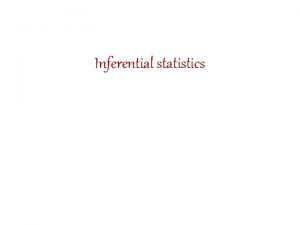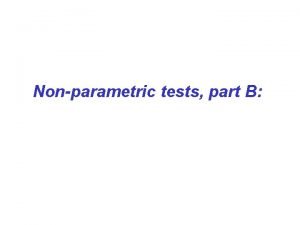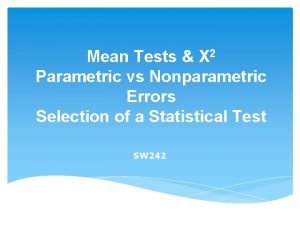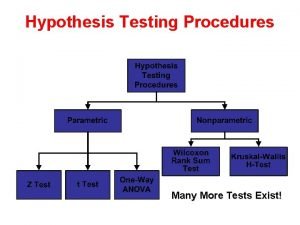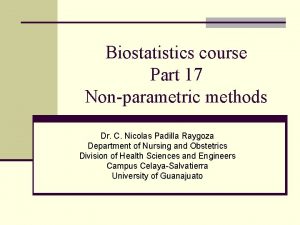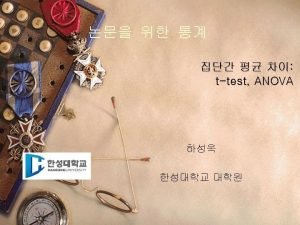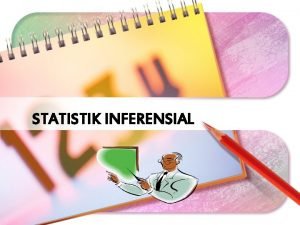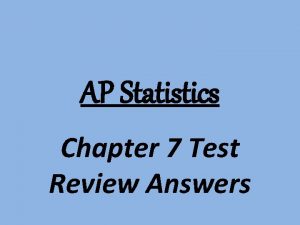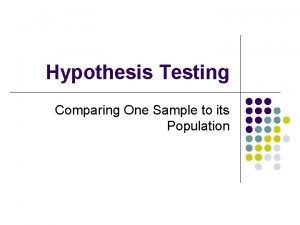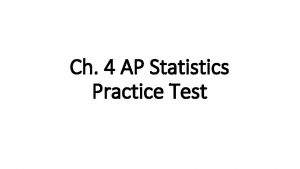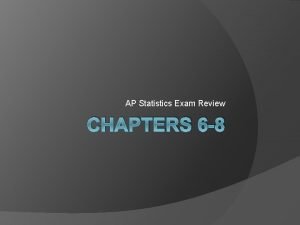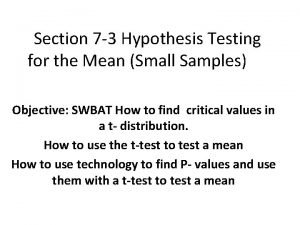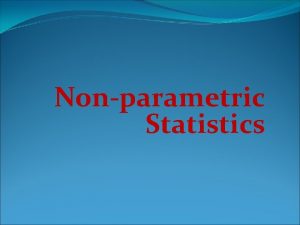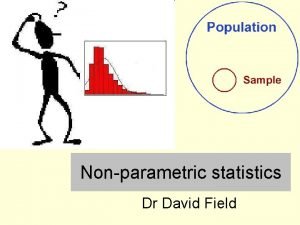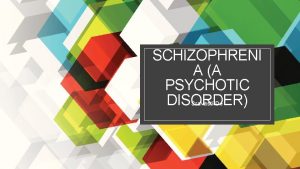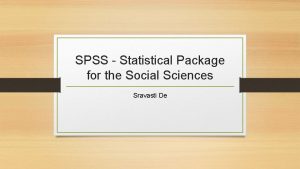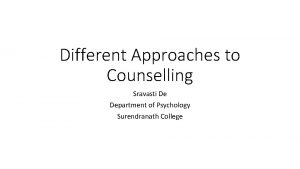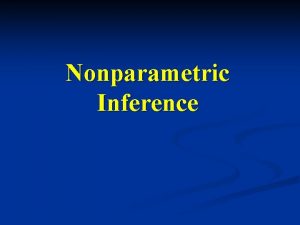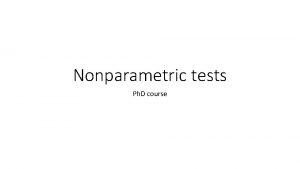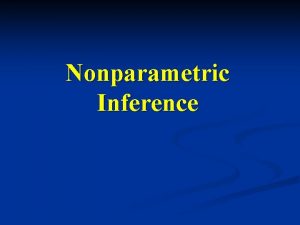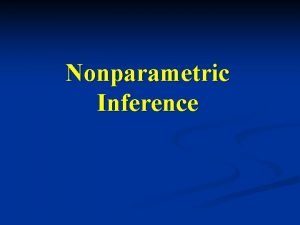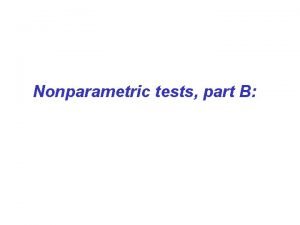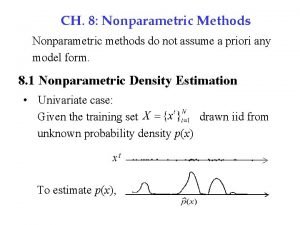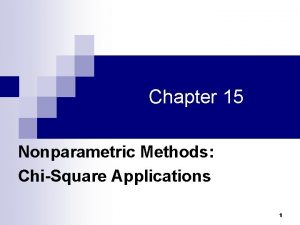NONPARAMETRIC STATISTICS Sravasti De Nonparametric Test Those procedures















- Slides: 15

NONPARAMETRIC STATISTICS Sravasti De

� Nonparametric Test: Those procedures that test hypotheses that tests hypotheses that are not statements about population parameters are classified as nonparametric. � Distribution free procedure: Those procedures that make no assumption about the sampled population are called distribution free procedures. � However, both these terms Nonparametric and distribution free are used interchangeably and under the common heading „Nonparametric‟. INTRODUCTION

Advantages: � Nonparametric statistics allow for the testing of hypothesis that are not statements about population parameter values. � It may be used when the form of the sampled population is unknown. � Computationally easier. � May be applied when the data being analyzed consists merely of rankings or classifications. Disadvantages: � Nonparametric procedure with data that can be handled with a parametric procedure results in a waste of data. � Application of the Nonparametric tests may be laborious for large samples. ADVANTAGES &DISADVANTAGES:

Non-parametric tests can be applied when: – Data don’t follow any specific distribution and no assumptions about the population are made – Data measured on any scale ASSUMPTIONS

Commonly used Non Parametric Tests are: − - Chi Square test − The Sign Test − Wilcoxon Signed-Ranks Test − Mann–Whitney U or Wilcoxon rank sum test − The Kruskal Wallis or H test − Friedman ANOVA − The Spearman rank correlation test COMMONLY USED TESTS

• First used by Karl Pearson • Simplest & most widely used non-parametric test in statistical work. • Calculated using the formula- χ2 = ∑ ( O – E )2 /E : O = observed frequencies E = expected frequencies • Greater the discrepancy b/w observed & expected frequencies, greater shall be the value of χ2. • Calculated value of χ2 is compared with table value of χ2 for given degrees of freedom. Karl Pearson (1857– 1936) CHI SQUARE TEST

• Application of chi-square test: • Test of association (smoking & cancer, treatment & outcome of disease, vaccination & immunity) • Test of proportions (compare frequencies of diabetics & non-diabetics in groups weighing 40 -50 kg, 50 -60 kg, 60 - 70 kg & >70 kg. ) • The chi-square for goodness of fit (determine if actual numbers are similar to the expected/theoretical numbers) CHI SQUARE TEST

• Yates’ correction: applies when we have two categories (one degree of freedom) • Used when sample size is ≥ 40, and expected frequency of <5 in one cell • Subtracting 0. 5 from the difference between each observed value and its expected value in a 2 × 2 contingency table • χ2 = ∑ [O- E-0. 5]2/ E CHI SQUARE TEST

• Used for paired data, can be ordinal or continuous • Simple and easy to interpret • Makes no assumptions about distribution of the data • Not very powerful • To evaluate H 0 we only need to know the signs of the differences • If half the differences are positive and half are negative, then the median = 0 (H 0 is true). • If the signs are more unbalanced, then that is evidence against H 0. SIGN TEST

• Nonparametric equivalent of the paired t-test. • Similar to sign test, but take into consideration the magnitude of difference among the pairs of values. (Sign test only considers the direction of difference but not the magnitude of differences. ) WILCOXON SIGNED-RANK TEST

• Mann-Whitney U – similar to Wilcoxon signed-ranks test except that the samples are independent and not paired. • Null hypothesis: the population means are the same for the two groups. • Rank the combined data values for the two groups. Then find the average rank in each group. • Then the U value is calculated using formula • U= N 1*N 2+ Nx(Nx+1) _ Rx (where Rx is larger rank 2 total) • To be statistically significant, obtained U has to be equal to or LESS than this critical value. MANN-WHITNEY U TEST

• It’s more powerful than Chi-square test. • It is computed exactly like the Mann-Whitney test, except that there are more groups (>2 groups). • Applied on independent samples with the same shape (but not necessarily normal). KRUSKAL-WALLIS ONE-WAY ANOVA

• Friedman ANOVA: When either a matched-subjects or repeatedmeasure design is used and the hypothesis of a difference among three or more (k) treatments is to be tested, the Friedman ANOVA by ranks test can be used. FRIEDMAN ANOVA

• Use to assess the relationship between two ordinal variables or two skewed continuous variables. • Nonparametric equivalent of the Pearson correlation. • It is a relative measure which varies from -1 (perfect negative relationship) to +1 (perfect positive relationship). Charles Spearman (1863– 1945) SPEARMAN RANK-ORDER CORRELATION

Ref: Sheskin, David J. (2003) Handbook of Parametric and Nonparametric Statistical Procedures. CRC Press. ISBN 1 -58488 -440 -1 Corder, G. W. ; Foreman, D. I. (2014). Nonparametric Statistics: A Stepby-Step Approach. Wiley. ISBN 978 -1118840313. THANK YOU
 Experimental hypothesis
Experimental hypothesis Nonparametric test
Nonparametric test Parametric vs nonparametric test
Parametric vs nonparametric test Parametric and nonparametric tests
Parametric and nonparametric tests Is parametric data normally distributed
Is parametric data normally distributed Nonparametric methods
Nonparametric methods Parametric nonparametric 차이
Parametric nonparametric 차이 Introduction to statistics what is statistics
Introduction to statistics what is statistics Ciri ciri one sample t test
Ciri ciri one sample t test Ap statistics unit 7 test answer key
Ap statistics unit 7 test answer key Hypothesis test statistics formula
Hypothesis test statistics formula Chapter 4 ap statistics practice test
Chapter 4 ap statistics practice test Chapter 6 ap statistics review
Chapter 6 ap statistics review Probability and statistics chapter 3 test answer key
Probability and statistics chapter 3 test answer key University clinical aptitude test
University clinical aptitude test Hypothesis testing meaning
Hypothesis testing meaning
